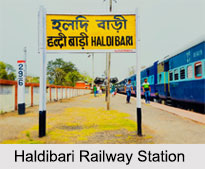 Haldibari municipality is situated in the western side of Cooch Behar District and is situated at an elevation of 187 metres. The annals of Haldibari depicts that formerly it was a land mark of ancient civilization and trade centre. The Teesta River and its direction have settled the prosperity of trade, commerce, transport and finally the geographical location of Haldibari town.
Haldibari municipality is situated in the western side of Cooch Behar District and is situated at an elevation of 187 metres. The annals of Haldibari depicts that formerly it was a land mark of ancient civilization and trade centre. The Teesta River and its direction have settled the prosperity of trade, commerce, transport and finally the geographical location of Haldibari town.
The Haldibari town have the villages Kachua Boalmari and some parts of Kharija Barubari of Jalpaiguri district in its northern side, some parts of Kharija Barubari, Daksin Barubari in western side and the areas of its entire southern part belongs to border of Bangladesh and its eastern part consists of the Rangpur area district of Bangladesh.
Demographics of Haldibari
As per the reports of Census India 2011, the total population of Haldibari is 14,404 out of which 7,306 are males while 7,098 are females. The population of children between the ages 0 to 6 years is 1341 which is 9 percent of the total population. Female sex ratio is of 972 against state average of 950. The child sex ratio of the town is around 913 compared to the state average of 956. The literacy rate of Haldibari city is 83.96 percent which is more than the state average of 76.26 percent. In Haldibari, the male literacy is around 87.57 percent while the female literacy rate is 80.27 percent.
Climate of Haldibari
Haldibari experiences 3 seasons, namely summer, monsoon and winter. The temperature reaches around 35 degree C during the summers and in extreme winter the temperature sometimes reaches below about 5 degree C.
The Haldibari Railway Station is known to be quite famous and is the first Railway Station in the north-eastern India and was under the jurisdiction of Northern Bengal state railway. In the later years it was presumed that the expansion of railway link from Kolkata to Haldibari was made to promote the export of jute, tea and tobacco from North Bengal and Assam. Partition of Bengal resulted in major changes in the railway system of Haldibari as the border areas of the Bangladesh were situated in between Haldibari and Chilahati station. During the subsequent years the development of the railway link from Haldibari to Kolkata was made in phases. Finally direct railway link between the two cities of Kolkata and Haldibari was established via New Jalpaiguri in the year 1982.
Visiting Information on Haldibari
The Bagdogra Airport and the Cooch Behar Airport are 59 km and 68 km away from Haldibari respectively. The city has its own railway station called the Haldibari Railway Station which is connected by trains to Kolkata.



















